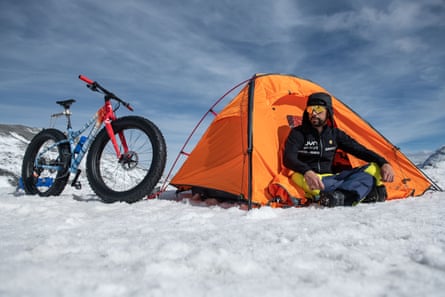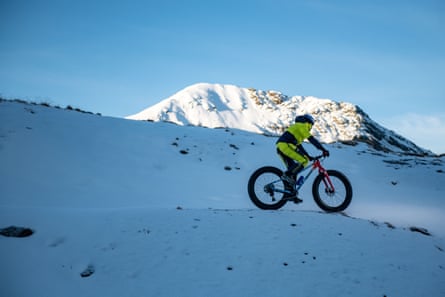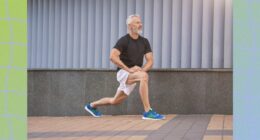Climate activist Omar di Felice hopes to complete the 2,000km trek – made possible by advent of ‘fatbikes’ – in 60 days after departing next week
Next week, Omar di Felice will begin a journey no human has previously attempted. The Italian ultra-endurance cyclist will arrive at Hercules Inlet, in western Antarctica, and begin cycling over the ice towards the south pole. All going well, he will ride for 60 days through almost 2,000km of treacherous terrain, passing the pole and reaching Leverett Glacier in mid-January to complete the first-ever coast-to-coast crossing on a bike.
Cycling in Antarctica is a relatively recent phenomenon, made possible by the development of wide-tired bicycles known as “fatbikes”, which can traverse snowy conditions. The first Antarctic cycling expedition took place in 2003; in the years since, just two men have managed to ride the full distance from Hercules Inlet to the south pole (about 1,250km). No one has yet ridden onwards to complete a coast-to-coast crossing of the continent.
“I know that it will be a really hard challenge,” says di Felice, speaking to the Guardian from Italy before he flies to Chile and then on to the Hercules Inlet airstrip. “I’m not sure I will be able to do so – because it’s very hard. But I just want to try, it’s an attempt. It’s a hard attempt, but why not try?”
Di Felice is no novice when it comes to ambitious cycling adventures. A former professional road cyclist, the 41-year-old transitioned to expedition cycling early in his career and has not looked back. In 2014 he became the first cyclist to ride to North Cape in Norway, near the northernmost tip of continental Europe, during winter; he has also ridden through Alaska, Canada and the Gobi Desert in Mongolia.

But the Italian admits that Antarctica will be something else entirely. “I hope that I am ready for the most extreme adventure of my life,” he says. “Everyone I speak with says I’m crazy, it’s impossible, the bike won’t go over because of the deep snow and the wind. It’s very hard for cycling – but I’ll just go and explore and find out for myself whether it’s possible or not.”
Di Felice will roll out from Hercules Inlet next weekend (the weather will determine exactly when his flight can depart Punta Arenas in southern Chile). The first part of his journey will be the hardest, over what will sometimes be virgin terrain – di Felice estimates he will cover just 20 or 30km a day. From the south pole, he will ride along a compacted ice road that links the Pole with McMurdo station – where he hopes to achieve 50 or 60km a day.
But di Felice will have to keep up the pace: his permission to remain in Antarctica expires on 20 January. “I will have to be really fast if I want to do the crossing,” he laughs.
READ RELATED: Television star Shelly Horton says she was left 'sobbing' after being abused by rude Uber driver
Di Felice will tackle this epic journey with a customised fatbike made from steel. “Carbon is worse than steel in cold conditions,” he says. But even with a dedicated bike, it is unlikely he will be riding the whole time. Eric Larsen, who attempted to ride from Hercules Inlet to the south pole in 2013, recently told ExplorersWeb that, given the conditions, “cycling off-road in Antarctica means walking your bike”.
As he rides, or walks, di Felice will be pulling a sled carrying his tent, supplies and plenty of warm clothing (temperatures could fall to as low as minus 38C). He is riding unsupported, although can refuel at the south pole if necessary (the expedition is not formally considered unsupported by the Polar Expeditions Classification Scheme because his route partly follows a constructed ice road). Di Felice estimates he will consume 4,500 calories each day: a breakfast of muesli and dried fruit, energy bars for lunch as he rides for eight to 10 hours, and then a dried meal before bed.
‘We can change the world with a bike’
Di Felice has dreamed of Antarctica since he was a child, watching movies about Italian polar explorers such as Reinhold Messner, the first person to cross Antarctica by foot. “Now as a cyclist, an ultra-cyclist, I try to mix my job with my passion for the polar conditions,” he says. “And this big adventure is a mix of all my passions.” Di Felice adds that the history of Antarctic exploration spurs him onwards. “The big adventures of the past inspire me to reach my limits, to pass my limits.”
But in addition to fulfilling his childhood aspirations, there’s a more serious message behind di Felice’s expedition. The cyclist is a climate activist through his Bike to 1.5C project. “It’s a project that connects my adventures to a scientific program to raise awareness about climate change,” he says. “The bicycle is the best vehicle to tell the story of climate change and raise awareness about reducing our carbon footprint.”

Last year di Felice attended Cop26 in Glasgow, riding to Scotland from Milan. “It was really symbolic – we showed to the world that we can change the world, with a bike,” he says. He has also partnered with the Italian Climate Network and the European Space Agency as part of his awareness-raising mission. “We have to tell the story of Antarctica and why Antarctica is so fragile [due to climate change].”
Whether or not di Felice makes history in the coming months, he insists he will be content with his effort. “The most important thing is to think you can do it,” he says. “I will be happy even if I don’t reach the other coast.”
Nor does he think this will be his last expedition. “The world is very big and there a lot of places we can explore with our bike,” he says. “Maybe I will come back to Antarctica and try again, maybe I will try another part of Antarctica, maybe I will go to the north pole. There are a lot of things to do – I can’t imagine retiring.”
But whatever comes next, di Felice will continue to spread his message of climate action through daring feats. “We can change the world if we use the bike every day,” he says. “To go to work, to go to school, even to have some extreme journeys. My will is to show people that with the bike we can do everything – we can even go to Antarctica.”
Source: Health & wellbeing | The Guardian




